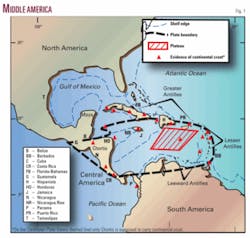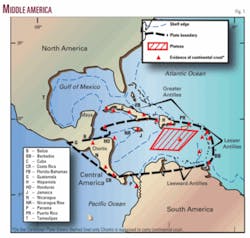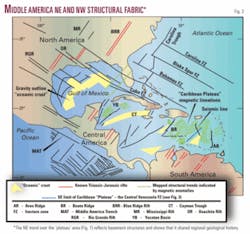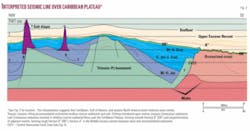That the Caribbean Plate formed in the Pacific is a 40-year-old idea, and there is much evidence that continental crust is abundant.
Recent huge discoveries below salt in the Gulf of Mexico and Brazil show that much remains to be learned about deepwater areas. They also disprove the notion that the elephants have all been found.
Another paradigm that needs to fall is the 40-year-old idea that the Caribbean Plate formed in the Pacific and migrated between the Americas. This understanding implies that the plate consists mostly of oceanic crust and volcanic arc rocksnot many think about hunting for oil in deep water here. However, there is much evidence (continental rocks, continental gravity densities, seismic velocities and crustal thicknesses, abundant high-silica rocks, and regional tectonic fabric) that continental crust is abundant (Figs. 1 and 2).
Middle America, including the Caribbean Plate, exhibits a regional NE and NW structural pattern (Fig. 2). The former reflects Triassic-Jurassic rift/drift reactivation of Paleozoic sutures and is well known in North and South America. The latter is the trend of ocean fractures and major intracontinental faults active during northwestward separation of North America from Gondwana.
Major Jurassic faults crossing the Maya and Chortis blocks in the west (Fig. 1) remain parallel to the regional NE trend (Fig. 2) and show that they have not rotated, as commonly believed. Continental rocks are exposed on mainland Chortis, but this block extends to Jamaica via the Nicaragua Rise and forms a large part of the western Caribbean. Its presence there precludes migration of a Pacific plate both geometrically and geologically.
Part of the Caribbean Plate is up to 20 km thick. Deepsea Drilling Project holes encountered Turonian basalts at the top of this Caribbean “oceanic plateau” (Fig. 1), which is generally seen to be the result of Cretaceous oceanic plate thickening over a hot spot or mantle plume in the Pacific.
If this were true, the plateau would exhibit a radial structural pattern. Instead, it shares the regional NE trend of Middle Americaan unlikely coincidence if it had formed in the Pacific.
Seismic data over the plateau (Fig. 3) reveal a deep architecture that repeats the form of distal basins along the eastern seaboard of North America from Baltimore Canyon to the Blake Plateau. These asymmetric basins contain wedges of Triassic red beds and Jurassic-Cretaceous sediments, source rocks, and salt. They share the Gulf of Mexico history of Mesozoic extension.
The Caribbean “plateau” is probably their southern continuation. Instead of blocks of vertical igneous dykes flanked by wedges of volcanic flows and volcaniclastic sediments, with seamounts locally at the seafloor (current understanding), it probably consists of 40-km-wide continental blocks flanked by 100-km-wide wedges of Triassic-Jurassic clastic sediments, including source rocks and salt, overlain by Jurassic-Cretaceous carbonates.
Smoothness and great lateral extent of seismic Horizon B” (Fig. 3) and vesicularity of cored Turonian basalts suggest they were shallow/subaerial, perhaps causing restriction that produced prolific source rocks known along northern South America. Supposed seamounts that push up through overlying upper Cretaceous-Recent sediments are very similar in appearance to Sigsbee salt knolls of the Gulf of Mexico. At least some are salt diapers, with indications of adjacent rim synclines.
Other parts of the Caribbean Plate, west and southeast of the plateau, resemble oceanic crust (Fig. 3, Rough Horizon B”). However, they are abnormally thin (3-4 km) and do not manifest spreading magnetic anomalies. They are likely to be areas of extremely attenuated continental crust or serpentinized upper mantle (serpentinite is remarkably abundant around the plate margins). The only spreading anomalies (Miocene-Recent) in the whole of Middle America occur in the central 300 km of the Cayman Trough.
Instead of bearing a “foreign” Caribbean Plate, Middle America shows an internal geological integrity that reflects ancient basement structures extended by drift of North America away from and South America. Proximal margins subsided gradually, accommodating carbonate platforms many kilometers thick (Florida-Bahamas, Tamaulipas, Campeche-Maya). More distal areas foundered below the deeper Gulf of Mexico and the Caribbean. Areas of greatest extension suffered “oceanization.”
Caribbean geology is related to that of the Gulf of Mexico and marginal basins along the eastern flanks of the Americas.
The area lies between the giant oil provinces of the Gulf of Mexico and northern South America. It probably carries a wide variety of hydrocarbon plays involving Jurassic and Cretaceous source rocks. The risk is that igneous activity overmatured these in some areas. However, live oil stain occurs in fractured rocks on Puerto Rico, oil is present on Hispaniola, Jamaica, Belize, Guatemala, Honduras, Nicaragua, Costa Rica, Panama, and Barbados. Some is thought to come from Tertiary sources, but oils of Guatemala, Belize, Jamaica, Costa Rica, and Barbados have Jurassic or Cretaceous chemical signatures.
This 2.5 million sq km, virtually unexplored area lies close to North America and is governed by friendly nations.
The author
Keith James ([email protected]) is a consulting geologist that specializes in Central and South America. After 8 years of teaching, he joined Shell International and worked Gabon, Spain, Venezuela, UK, Netherlands, and the US, becoming geological advisor to Global Exploration in The Hague. He then joined Conoco as senior vice-president exploration and chief geoscientist, international studies, Houston. He is the author of the only published, comprehensive synthesis of Venezuelan hydrocarbon geology. He is organizing a workshop on Caribbean geology in June 2008 and an international conference in June 2009. He has an MS in biostratigraphy from the University of Houston and an MSc in micropalaeontology and PhD in marine geology from the University of Wales.




